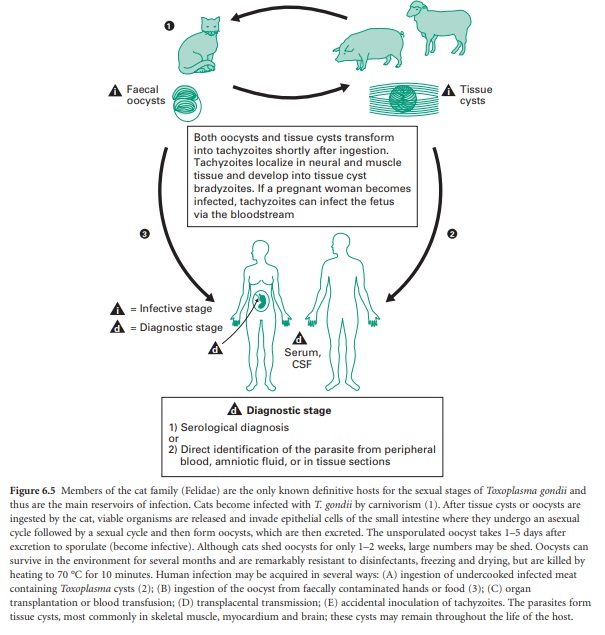Giardia lamblia (syn. intestinalis, duodenalis) - Intestinal Parasites
| Home | | Pharmaceutical Microbiology | | Pharmaceutical Microbiology |Chapter: Pharmaceutical Microbiology : Protozoa
Giardia duodenalis (syn lamblia and intestinalis) is the causative agent of giardiasis, a severe diarrhoeal disease. The incidence of Giardia infection worldwide ranges from 1.5% to 20% but is probably significantly higher in countries where standards of hygiene are poor.
Giardia lamblia (syn. intestinalis, duodenalis)
Giardia duodenalis (syn lamblia
and intestinalis) is the causative agent of giardiasis, a severe
diarrhoeal disease. The incidence of Giardia
infection worldwide ranges from 1.5% to 20% but is probably significantly higher
in countries where standards of hygiene are poor. The most common route of spread
is via the faecal–oral route, although spread can also occur through ingestion
of contaminated water and these modes of transmission are particularly
prevalent in institutions, nurseries and daycare centres. Recent outbreaks and
epidemics in the UK, USA and eastern Europe have been caused by drinking
contaminated water from community water supplies or directly from rivers and
streams. Many animals harbour Giardia
species that are indistinguishable from the human infective types. There is now
clear evidence from genotyping studies (see section 6.1.2) that the G. duodenalis
species is made up of a number of genetically distinct groups which may represent species. This has raised the
question of the existence of animal reservoirs of Giardia. Recent findings of Giardia infected
animals in watersheds from which humans acquired giardiasis, and the successful
interspecies transfer of these organisms, suggests that human giardiasis can be
acquired by zoonotic transfer, however it is not clear if the major route of
transfer is from animal to human or from human to animal. More recently, it has
been recognized that Giardia infection
may be transmitted by sexual activity, particularly
among homosexual men.
This organism exhibits
only two life cycle forms: the vegetative binucleate trophozoite (10–20 μm long × 2 –3 μm wide) (Figure 6.2d)
and the transmissible quadranucleate cyst (10–12 μm long × 1–3 μm wide). Trophozoites have four pairs of
flagella and an adhesive disc, which is thought to help adhesion to the intestinal
epithelium. Division in trophozoites is by longitudinal fission.
It was long believed
that Giardia was a non-pathogenic
commensal. However, we now know that Giardia
can produce disease ranging from a self limiting diarrhoea to
severe chronic syndrome.
Immune competent individuals with giardiasis may exhibit some or all of the
following signs and symptoms: diarrhoea or loose, foul smelling stools; steatorrhoea (fatty
diarrhoea); malaise; abdominal cramps; excessive flatulence; fatigue and weight
loss. Infected individuals with an immune deficiency or protein-calorie
malnutrition may develop a more severe disease and will exhibit symptoms such
as interference with the absorption of fat and fat-soluble vitamins, retarded
growth, weight loss, or a coeliac disease like syndrome.

Giardia infection is initiated by ingestion of viable cysts (Figure 6.6), the infective dose of which can be as low as
one cyst, although infection initiated by 10–100
viable cysts is more
likely. As the cysts pass through the stomach the low pH and elevated CO2
induce excystation (cyst–trophozoite transformation). From each cyst two
complete trophozoites emerge and these rapidly undergo division then attach to
the duodenal and jejunal epithelium. Once attached, they will undergo division,
and 4–7 days later they will detach and begin to round up and form cysts
(encystment). This process is thought to be induced in response to bile. The
first cysts are found in faeces after 7–10 days.
The underlying pathology
of giardiasis is not fully understood. The trophozoites do not invade the
mucosa, and although their presence may have some physical effects on the
surface it is more likely that some of the pathology is caused by inflammation
of the mucosal cells of the small intestine causing an increased turnover rate
of intestinal mucosal epithelium. The immature replacement cells have less
functional surface area and less digestive and absorptive ability. This would
account for the microscopic changes seen in infected epithelia. It has been suggested
that other mechanisms may exist, e.g. toxin production, but to date no such
molecule has been observed.
Related Topics
